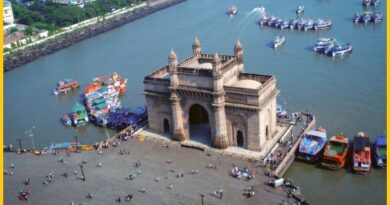Dhanushkodi Dreams-Footsteps of Myth and Modernity
Dhanushkodi
Dhanushkodi is a town located in the southeastern tip of the Indian state of Tamil Nadu. It is situated on Pamban Island, which is connected to the mainland by the Pamban Bridge. Dhanushkodi is known for its picturesque beach and its historical significance.
Geographically it is located at the confluence of the Bay of Bengal and the Indian Ocean. It is about 18 kilometers west of Sri Lanka. Dhanushkodi offers a unique blend of history, mythology, and natural beauty, making it an intriguing place to visit for those interested in exploring the cultural and historical heritage of the region.
Dhanushkodi History
Dhanushkodi has a rich history, with a mix of mythology, historical events, and natural disasters. According to Hindu mythology, Dhanushkodi is believed to be the place where Lord Rama built a bridge, commonly known as Adam’s Bridge or Rama Setu, to reach Lanka (modern-day Sri Lanka) and rescue his wife Sita from the demon king Ravana.
Dhanushkodi is considered to be one of the starting points of Ram Setu. It is believed to be the place where Lord Rama’s bow (Dhanush) was used to mark the spot for the construction of the bridge, hence the name Dhanushkodi, meaning the end of the bow. The town is often associated with the epic Ramayana.

The place was historically a bustling trade center, attracting merchants and traders from India and Sri Lanka. The town was well-connected by land and sea routes and served as an important point for maritime trade.
Cyclone of 1964- On the night of December 22, 1964, Dhanushkodi was devastated by a powerful cyclone. The cyclone, accompanied by high tidal waves, destroyed the town, claiming many lives and rendering the place uninhabitable. The railway line and the train on the Pamban-Dhanushkodi route were severely damaged, leading to the isolation of Dhanushkodi from the mainland.
Ghost town Dhanush Kodi
In the aftermath of the cyclone, Dhanushkodi was declared a ghost town, and the government decided not to rebuild the town due to the vulnerability of the area to natural disasters. The remnants of the buildings and the railway tracks are still visible, serving as a poignant reminder of the town’s tragic past.
Dhanushkodi is often referred to as a “ghost town” due to its abandoned and desolate state. Today, the remnants of Dhanushkodi’s old town can still be seen. The skeletal remains of buildings, the damaged railway tracks, and other infrastructure stand as a silent testimony to the once-thriving settlement that succumbed to nature’s fury.
Dhanushkodi beach
Dhanushkodi Beach is a beautiful and serene stretch of coastline located at the southeastern tip of Pamban Island. The Beach is known for its pristine and untouched beauty. The beach is surrounded by the Bay of Bengal on one side and the Indian Ocean on the other, providing breathtaking views of the sea.

Meeting Point of Seas- One of the unique aspects of Dhanushkodi Beach is that it is situated at the meeting point of the Bay of Bengal and the Indian Ocean. The confluence of these two water bodies adds to the charm of the place.
Sunset Views- Dhanushkodi Beach is an excellent spot to witness stunning sunsets over the sea. The changing colors of the sky during sunset create a picturesque scene, making it a favorite among photographers and nature enthusiasts.
Remote and Tranquil Atmosphere- Due to its remote location and limited accessibility, Dhanushkodi Beach has a tranquil and less crowded atmosphere. It offers visitors a peaceful and relaxing environment, away from the hustle and bustle of city life.
Ram Setu Dhanushkodi
Ram Setu, also known as Adam’s Bridge, is a chain of volcanic rocks like Amygdaloidal basalt and obsidian between Pamban Island, also known as Rameswaram Island, off the southeastern coast of Tamil Nadu, India, and Mannar Island, off the northwestern coast of Sri Lanka.
Mythological Significance- According to Hindu mythology, Ram Setu is believed to be the bridge constructed by Lord Rama, with the help of his army of monkeys and the sea god Varuna, to reach Lanka (modern-day Sri Lanka). This bridge was built to rescue his wife Sita from the demon king Ravana. The term “Setu” means bridge, and “Ram Setu” translates to “Rama’s Bridge.”
Dhanushkodi Tourist Places
Dhanushkodi, located at the southeastern tip of Pamban Island in Tamil Nadu, India, offers a unique mix of natural beauty, historical significance, and cultural richness. While the town itself is a ghost town with remnants of its past, the surrounding area has become a popular destination for tourists. Here are some of the notable tourist places in and around Dhanushkodi:
Dhanushkodi Beach- The pristine Beach is the primary attraction. The beach offers breathtaking views of the Bay of Bengal and the Indian Ocean, and visitors can witness the confluence of the two seas. The serene environment makes it an ideal spot for relaxation and photography.
Ram Setu View Point- Visit the Ram Setu View Point to get a panoramic view of the bridge-like formation between India and Sri Lanka. This area provides an opportunity to appreciate the cultural and mythological significance associated with Ram Setu.
Ghost Town Remnants- Explore the remnants of the old town of Dhanushkodi, including the remains of buildings, railway tracks, and other structures that were affected by the cyclone in 1964. The ghost town atmosphere adds a mysterious and historical touch to the visit.

Rameswaram Temple- While not in Dhanushkodi itself, the nearby town of Rameswaram is famous for the Ramanathaswamy Temple. This temple is one of the twelve Jyotirlinga shrines and is known for its architectural grandeur and religious significance.
Agni Theertham- A visit to Agni Theertham, the sacred sea in front of the Ramanathaswamy Temple, is considered auspicious for pilgrims. It is believed that taking a bath in the waters of Agni Theertham can wash away sins.
Gulf of Mannar Marine National Park- Explore the biodiversity of the Gulf of Mannar Marine National Park, which is not far from Dhanushkodi. This marine park is known for its coral reefs, marine life, and diverse ecosystems.
Kothandaramaswamy Temple- Located on the way to Dhanushkodi, this temple is believed to be the spot where Lord Rama performed the last rites for Jatayu, the eagle that tried to rescue Sita from Ravana.
Jada Tirtha- This is a sacred pond near Rameswaram Temple where pilgrims believe that Lord Rama washed his hair after killing Ravana. It is considered holy, and a dip in its waters is believed to purify the soul.
Things to do in Dhanushkodi
Dhanushkodi, with its historical significance and natural beauty, offers visitors a unique and tranquil experience. While it is a relatively remote and less developed area, there are several things to do in Dhanushkodi to make the most of your visit-
Visit Dhanushkodi Beach-
Spend time relaxing on the pristine Dhanushkodi Beach. Take a walk along the shore and enjoy the scenic views of the Bay of Bengal and the Indian Ocean.
Explore the Ghost Town Remnants-
Explore the remnants of the old town, including the abandoned buildings and the damaged railway tracks. Capture the eerie beauty of the ghost town through photography.
Witness the Confluence of Seas-
Visit the point where the Bay of Bengal and the Indian Ocean meet, providing a unique natural spectacle. Enjoy the breathtaking views of the confluence.
Take a Dip in the Sea-
Enjoy a swim in the calm waters of the sea. Be mindful of the currents and follow safety guidelines.

Ram Setu Viewpoint-
Visit the Ram Setu Viewpoint for panoramic views of the bridge-like formation between India and Sri Lanka. Understand the cultural and mythological significance of Ram Setu.
Participate in Spiritual Activities-
If interested, participate in spiritual activities at the nearby Ramanathaswamy Temple in Rameswaram. Take a dip in Agni Theertham for its religious significance.
Enjoy Sunset Views-
Witness the mesmerizing sunset over the sea. The changing colors of the sky make for a beautiful and serene experience.
Stargazing- In the remote setting of Dhanushkodi, the night sky can be quite clear. Consider stargazing for a peaceful and enchanting experience.
Local Cuisine-
Try local South Indian cuisine in nearby towns like Rameswaram. Savor seafood dishes, a specialty in coastal regions.
How to Reach Dhanushkodi
Reaching Dhanushkodi involves traveling to the nearby town of Rameswaram, as Dhanushkodi itself is not easily accessible by regular vehicles due to its remote and less developed nature. Here are the general ways to reach Dhanushkodi-
The nearest airport is the Madurai Airport, located approximately 167 kilometers away from Rameswaram. From Madurai, you can hire a taxi or take a bus to reach Rameswaram.
Rameswaram is well-connected by train, and it has its railway station. Regular trains from various parts of India connect to Rameswaram.
Rameshwaram to Dhanushkodi
To travel from Rameswaram to Dhanushkodi, you’ll typically need to take a short journey by road, as Dhanushkodi is situated on the southeast tip of Pamban Island, and there’s no direct railway or regular road connectivity to the town.
Once you are in Rameswaram, you can hire a local jeep or take a government-approved vehicle to reach Dhanushkodi. The journey from Rameswaram to Dhanushkodi involves traveling on sandy terrain, and a sturdy vehicle is recommended for this stretch.

Dhanushkodi to Sri Lanka distance
The distance from Dhanushkodi, India, to Sri Lanka is relatively short, considering their geographical proximity. It is located on the southeastern tip of Pamban Island, and it is separated from Sri Lanka by the Palk Strait. The distance between Dhanushkodi and Sri Lanka is approximately 30 kilometers at its closest point.
The Palk Strait is a shallow strait that separates India and Sri Lanka, and it includes various small islands, sandbanks, and the famous Adam’s Bridge (Ram Setu). While Dhanushkodi is the closest point on the Indian side, the distance can vary depending on the specific location in Sri Lanka that you are considering.
It’s important to note that there is no direct road or bridge connection between Dhanushkodi and Sri Lanka. The most common way to travel between the two locations is by sea, and historically, there have been ferry services or boats connecting Rameswaram to Talaimannar in Sri Lanka.



